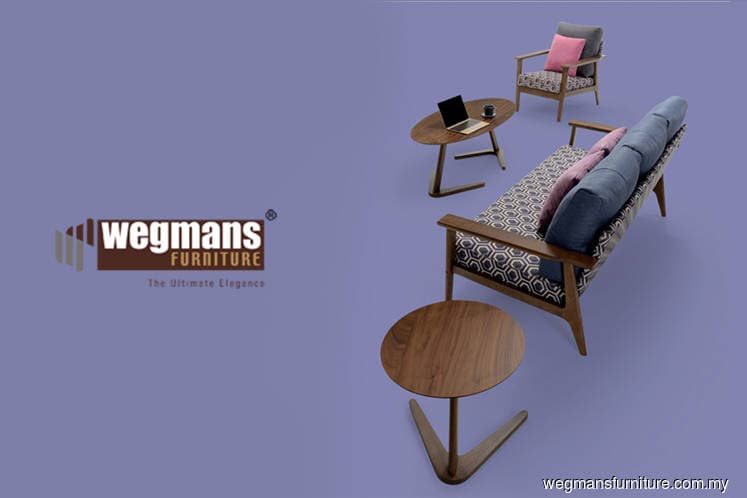
This article first appeared in Capital, The Edge Malaysia Weekly on March 5, 2018 - March 11, 2018
WEGMANS Holdings Bhd has set its sights on entering the European market within the next three years as it expands its production capacity.
Based in Muar, Johor, the furniture maker already derives 99% of its revenue from exporting to 14 countries, in addition to its domestic presence. Japan and the US are its largest markets, currently accounting for over 20% and 18% of revenue respectively. This is followed by Australia, the UK and Singapore at 15%, 12% and 3.4% respectively. However, the group has yet to establish a presence in any European country.
“We will source suitable sales agents in European countries to market our home furniture products by the first quarter of 2019,” Wegmans says in its initial public offering prospectus. The group also intends to take part in international furniture trade exhibitions in Europe, said executive director Collin Law at the launch of the group’s prospectus on Feb 13.
Wegmans aims to raise RM29 million from the issue of 100 million new shares, at an offer price of 29 sen per share, and listing on the ACE Market on March 6. A total of 50 million existing shares were also placed out to institutional and identified investors.
It will double its production capacity by spending RM11 million or 38% of the proceeds on capital expenditure, including the construction of a new factory. Some RM11 million will be used for the purchase of new machinery and equipment, according to the prospectus, while RM3.5 million will be used for working capital and the remaining RM3.5 million for listing expenses.
The new production facility, known as Phase 1 of its expansion plans, is expected to be up and running in the fourth quarter of next year. It will increase annual production capacity to 960,000 chairs and 380,000 tables for the dining room, living room and bedroom. The first phase also includes a workers’ hostel and a management office with showrooms.
Phases 2 and 3 will see the construction of an additional three factories.
“It is expected that our new factories for manufacturing production and the new management office, showrooms and workers’ hostel will be fully operational by the second quarter of 2020,” said Law.
High valuation reflects product quality
The group is being listed at a price-earnings ratio of 9.42 times, based on its an annualised net earnings per share of 3.08 sen for the nine months ended Sept 30, 2017.
While this may appear pricey based on the PERs of its peers, such as Lii Hen Industries Bhd and Poh Huat Holdings Bhd, the group’s positioning as a premium furniture maker justifies its valuation, with the offer price reflecting the quality of the group’s products, Law said.
According to TA Securities, the industry saw an average PER of 6.5 times for 2017.
“We value the company at 11 times its forecast 2018 calendar year EPS, arriving at a fair value of 31 sen per share,” TA Securities analyst Ooi Beng Hooi says in a Feb 19 note.
Inter-Pacific Research Sdn Bhd has a fair value of 33 sen on the stock, based on forecast EPS of 3.3 sen for FY2018.
“In the event of an early commissioning of its new plant, an earnings estimate upgrade will become necessary,” Inter-Pacific Research analyst Wong Ling Ling says in a Feb 22 note.
Global furniture consumption import value is expected to rise to US$152.9 billion in 2019 from US$143.9 billion last year, at a compound annual growth rate (CAGR) of 3.08%, according to an independent market report by Smith Zander.
In addition, there has been a government-enforced ban on rubberwood products since July 1 last year, in order to prevent timber shortages for local furniture manufacturers.
However, TA Securities’ Ooi says, “Given the gradual growth projected for key markets, coupled with the fact that Wegmans’ plant is running near full capacity, we expect tepid earnings growth until the new capacity kicks in in 2020.”
External risks remain
While the group’s competitive advantages lie in its wide selection of designs for home furniture through continuous product design and development activities, stringent quality control and established business relationships, it faces several notable risks to its earnings strength.
Challenges include significant increases in the prices of raw materials, appreciation of the ringgit, which would make its products less competitive in its export markets, and its dependence on foreign workers.
While a strengthening ringgit against the US dollar will negatively impact Wegmans’ top line, Law says the group will keep a close eye on the exchange rate and adjust prices in order to maintain profit levels.
In FY2016, a 5% decrease in the US dollar/ringgit exchange rate would have led to a 15.63% decline in gross profit to RM21.72 million, Wegmans says in its prospectus.
“For FY2016, about 98.42% of revenue and 9.53% of purchases were denominated in US dollars,” Wegmans says. The remaining sales and purchases were in ringgit.
With 84.22% of its workforce comprising foreign labour, margins may be squeezed going forward as it has had to pay the new levy for foreign workers since Jan 1.
However, price adjustments and the continuous launch of new designs are expected to help the group maintain positive profit margins in the years to come, Law said.
And the expansion of capacity will include more advanced machines and increased automation to reduce its dependence on foreign labour.
Save by subscribing to us for your print and/or digital copy.
P/S: The Edge is also available on Apple's AppStore and Androids' Google Play.